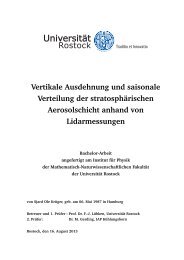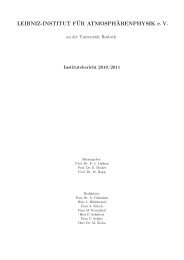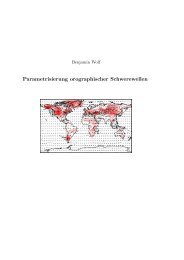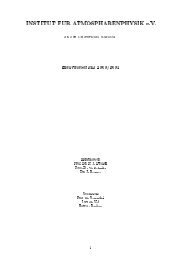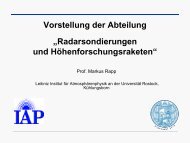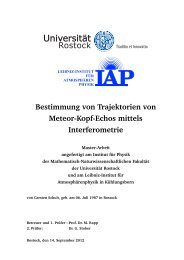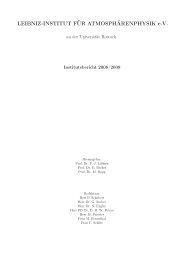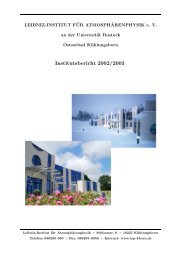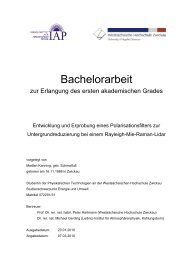Polar mesosphere summer echoes (PMSE): review of ... - HAL
Polar mesosphere summer echoes (PMSE): review of ... - HAL
Polar mesosphere summer echoes (PMSE): review of ... - HAL
Create successful ePaper yourself
Turn your PDF publications into a flip-book with our unique Google optimized e-Paper software.
M. Rapp and F. J. Lübken: Review <strong>of</strong> <strong>PMSE</strong> 2621<br />
Fig. 27. Scattering cross-section <strong>of</strong> the charged dust component<br />
relative to the Thomson scattering cross section as a function <strong>of</strong><br />
f =|Z A |N A /N e , with N e =1000 cm −3 and and an electron temperature<br />
T e =150 K for three values <strong>of</strong> the dust charge (Z A =Z=1,10,100)<br />
for the radar frequencies 224 MHz and 933 MHz (Hagfors, 1992).<br />
this process has so far been presented by Hagfors (1992).<br />
Figure 27 shows the scattering cross-section <strong>of</strong> the charged<br />
dust component relative to the Thomson scattering cross section<br />
as a function <strong>of</strong> =f =|Z A |N A /N e , with an electron<br />
number density N e =1000 cm −3 for three values <strong>of</strong> the dust<br />
charge (Z A =Z=1,10,100) for the radar frequencies 224 MHz<br />
and 933 MHz (Hagfors, 1992). Figure 27 shows that also<br />
this approach to explain <strong>PMSE</strong> in the UHF wavelength range<br />
is highly problematic: first <strong>of</strong> all, it becomes clear that<br />
the dressed aerosol scattering cross section only becomes<br />
larger than the cross section for Thomson scatter if either the<br />
aerosol particle charge becomes very high (i.e., Z A =Z>100)<br />
or if =f =|Z A |N A /N e ≫1, i.e., when the overall charge<br />
balance is completely dominated by the particle charge number<br />
density. While the first possibility (i.e., large Z A ) contradicts<br />
the available experimental and theoretical evidence<br />
on aerosol particle charging, the second possibility might<br />
at least in some cases be fulfilled (see Sect. 2.4.5). However,<br />
even if indeed =f =|Z A |N A /N e ≫1, it is clear that<br />
the dressed aerosol approach cannot explain the observed reflectivity<br />
dependence on the radar frequency (see Table 1)<br />
since the observations show that the scattering cross section<br />
at 224 MHz is ∼2–3 orders <strong>of</strong> magnitude larger than the one<br />
at 933 MHz whereas the dressed aerosol scatter theory only<br />
predicts a factor



